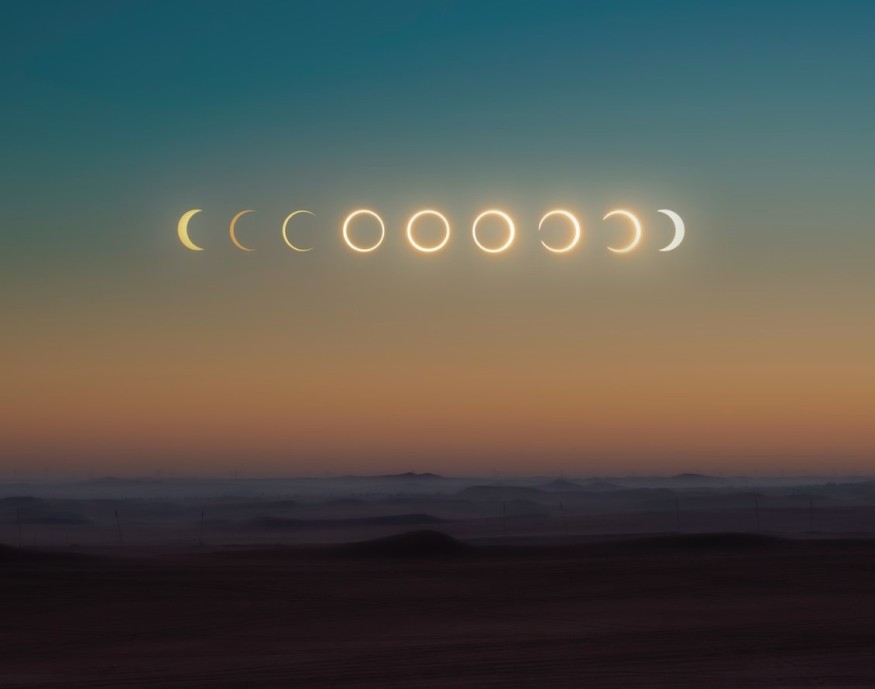
This week, North Americans can watch the annular solar eclipse of 2023, which is a rare 'Ring of Fire' eclipse. Here are five weird facts regarding the celestial event, as broad information about the eclipse has already been widely disseminated.
General Facts First, Weird Facts Later
On Saturday, October 14, 2023, a rare partial solar eclipse will grace North America. Millions of Americans can witness a fleeting "ring of fire." Eclipse enthusiasts worldwide will flock to several states for the annular eclipse, while others in a wider region will experience a partial eclipse.
Needless to say, special eye protection is absolutely essential when viewing the eclipse.
And now for the 5 weird facts:
#1 Ring of Fire From Big Sun and Small New Moon
The moon is too distant from Earth, or at apogee, to completely obscure the disk of the sun as it eclipses it, which results in the unusual appearance of the sun's ring-shaped outline around the new moon. The moon is positioned over the middle of the sun's disk, giving it a surreal-looking ring-shaped outline. Up to 91% of the sun will be shielded in this situation. Therefore, it is only a very partial eclipse.
#2 Where to View, Not Idaho
Most of the Americas will witness Saturday's solar eclipse, except for parts of Alaska, Chile, and Argentina. The annular eclipse path spans the Pacific Ocean, the US, Mexico, and more, concluding near Nicaragua at sunset.
Idaho is barely grazed by the "ring of fire" path, with just 43 square miles near Oregon and Nevada borders. Remote, but dirt roads allow a glimpse of a 1 minute 27 seconds "ring of fire."
The "ring of fire" will be visible from the Edzná archaeological site for 4 minutes and 32 seconds starting 11:23 AM CST, however, it will miss some of the more well-known Mayan temples near Campeche on Mexico's Yucatán Peninsula.
#3 Recorded 'Ancient Ring of Fire' Eclipse
In Nevada, close to Winnemucca, on the path of annularity, is Water Canyon, where an old petroglyph is believed to have depicted a solar eclipse. The sun's corona during a complete solar eclipse approximately a thousand years ago may be depicted in a petroglyph in Chaco Canyon, New Mexico, located about 850 miles farther down the route. It was etched by Ancestral Puebloan people.
Also Read : 2023 Draconid Meteor Shower Peaks Evening of Oct 8 to Oct 9 Morning, No Need for Binoculars!
#4 Latest, Next, and Echoes
On June 21, 2021, North America witnessed an annular solar eclipse, but the "ring of fire" was only visible in Canada. The last US "ring of fire" occurred on May 20, 2012, in the US Southwest near sunset.
The next annular solar eclipse on October 2, 2024, will be visible from Easter Island and Patagonia. The next US annular eclipse is on June 21, 2039, in Alaska, with a similar one in 2046.
Solar eclipses occur in cycles called saros, repeating every 18 years, 11 days, and eight hours. While the alignment remains nearly identical, Earth's rotation shifts the shadow's location. This eclipse is part of Saros 134, connected to annular eclipses on October 3, 2005 (Spain and northeast Africa) and October 25, 2041 (Japan and the Pacific Ocean).
#5 Death of The Sun
In Navajo culture, a solar eclipse, jóhonaa'éí daaztsą́ or "the death of the sun," signifies a fresh start. Navajo people observe it with fasting and prayer. As the sun reemerges, it's a time for rebirth and resolutions. From 8 AM to 1 PM MDT on October 14, 2023, Navajo Tribal Parks will close, respecting these beliefs.
Related Article : Ring of Fire Eclipse Appears From Oregon to Brazil on October 14, Here's How to Prepare for It
© 2025 NatureWorldNews.com All rights reserved. Do not reproduce without permission.





